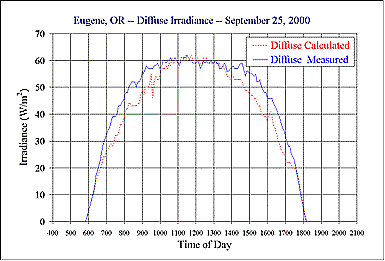Calculating diffuse radiation values
Diffuse irradiance refers to all the solar radiation coming from the sky except for solar radiation coming directly from the sun and the circumsolar irradiance within approximately three degrees of the sun.The measuremet of diffuse radiation is difficult because one needs to shade the pyranometer from the direct normal and the circumsolar irradiance. Before the development of high-quality automatic trackers, diffuse measurements were made with shadowbands that not only shaded the instrument from the sun but also shaded other parts of the sky. A fair estimate of the diffuse irradiance can be obtained by subtracting the direct normal beam radiation projected onto a horizontal surface from the global irradiance.
DHI = GHI - DNI * Cos(SZA)
The product of the direct normal beam irradiance times the cosine of the zenith angle yields the total amount of solar radiation on a horizontal surface coming directly from the sun. This is the horizontal beam irradiance. Adding the diffuse radiation to the horizontal beam radiation is equal to the total radiation (or more commonly call global horizontal irradiance) at a given location. Global irradiance is measured with a pyranometer sitting horizontally and if the pyranometer had a perfect cosine response, the difference between the horizontal beam irradiance and the global irradiance would equal to the diffuse irradiance. This is true instantaneously, and over longer time intervals this becomes a more approximate estimate of the diffuse irradiance because beam irradiance and the cosine of the incident angle change in a systematic manner over the interval, and the value of the beam horizontal irradiance is no longer equal to the average of the beam normal irradiance times the average of the cosine of the incident angle over the hour. We use a beam weighting function to average the cosine of the zenith angle over an hour. For more details see Frank Vignola and D. K. McDaniels, "Transformation of Direct Solar Radiation to Tilted Surfaces", Proceedings of the American Section of the International Solar Energy Society, Anaheim, California, p. 651, June 1984.
Unfortunately pyranometers do not have a perfect cosine response and subtracting the beam radiation from the global does lead to systematic errors in the calculated diffuse values. This is shown in the figure below. The data shown in the figure were taken on a clear day. The diffuse was measured with an Eppley PSP and a shade ball. The calculated diffuse data are from five-minute global and beam data measured with an Eppley PSP and NIP, respectively. In September in Eugene, the cosine response of the PSP is nearly correct during the middle of the day but underestimates the solar radiation during the morning and evening hours. This is typical of the deviation from the theoretical, Lambertian, cosine response. The degree of deviation from the Lambertian cosine response is an issue with all pyranometers.

Another source of systematic bias is that the thermopile of the PSP radiates to the sky and this reduces the amount of solar radiation counted by 10 to 20 watts per square meter. For global values, this difference is relatively small, but for diffuse values this can represent a 20° error. We adjust for part of this re-radiation by the sensor by adding the average nighttime values of this re-radiation to the daytime values. This works for the early morning and late evening hours fairly well, but for the middle of the day, the diffuse values measured with an Eppley PSP still have systematic values that are approximately 10 watts per square meter too low.
In August, 2000, we began measuring the diffuse radiation with a Schenk star-type pyranometer. A star-type pyranometer alternates black and white wedges and the incident solar radiation is the difference between the temperatures of the white and black wedges. Since the thermal re-radiation is about equal for the different wedges, the effect of re-radiation is nil. This makes star-type pyranometers ideal for the measurement of diffuse radiation.
